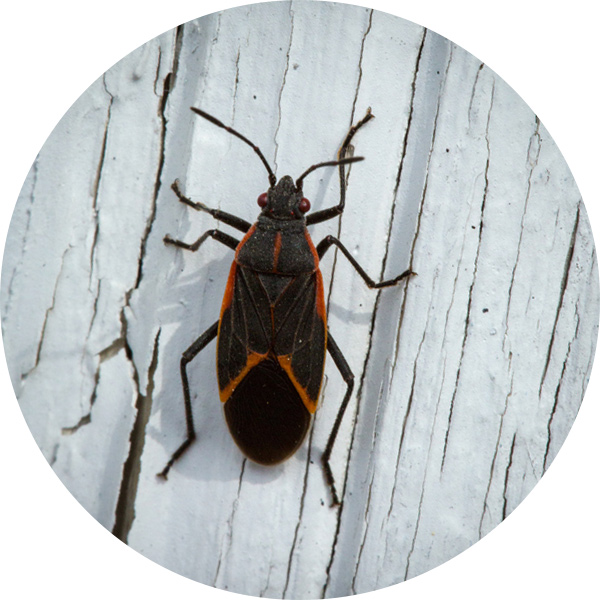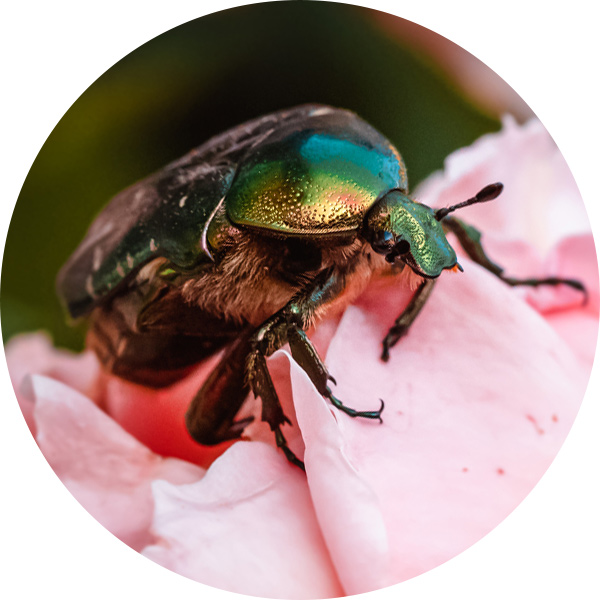
Boxelder Bug Facts & Information
A boxelder bug infestation is primarily a nuisance issue rather than a serious threat. While they may enter buildings in large numbers, they do not bite, sting, or transmit diseases to humans, and their presence is mostly a cosmetic problem that can be managed through preventive measures and targeted treatments if necessary.
Risks of Boxelders
Structural and Cosmetic Damage
Boxelder bugs do not cause significant structural damage to buildings, but their presence can still result in cosmetic damage. These bugs can leave reddish-orange stains on walls, curtains, furniture, and other surfaces when they are crushed or squashed. These stains can be challenging to remove and may require professional cleaning or repairs. Additionally, large aggregations of boxelder bugs can be unsightly and reduce the aesthetic appeal of homes or properties.
Indoor Invasion
Boxelder bugs often congregate on the exterior of buildings, particularly on sunny walls or surfaces. However, during certain times of the year, they can find their way indoors, seeking shelter and warmth. Once inside, they can become a nuisance, as they tend to gather in large numbers on windowsills, walls, or other indoor surfaces. Their presence can be alarming and disruptive, causing stress and discomfort for individuals residing in the infested property.
Agricultural Damage
While boxelder bugs primarily feed on boxelder trees and other seed-bearing plants, they can also damage agricultural crops, especially if their preferred host plants are not available. In large numbers, these bugs can feed on fruits, vegetables, and ornamental plants, causing aesthetic damage, scarring, or deformation of the produce. For commercial growers or farmers, boxelder bug infestations can result in financial losses if crops are adversely affected.

Truly Nolen GUARANTEE
If you’re not completely satisfied, you’ll get a full refund on your most recent service with our 100% money back guarantee.
Common Species of Boxelders

Standard Color Morph
How To Identify Boxelder Bugs
Boxelder bugs are small, black and red or orange insects commonly found in North America. They are known for congregating on boxelder trees and other types of trees, as well as entering buildings seeking shelter, though they are generally considered nuisance pests and do not cause significant damage.
Boxelder Appearance
Boxelder bugs (Boisea trivittata) are small insects belonging to the family Rhopalidae. They are approximately half an inch long and have a distinctive black and red coloration. Their bodies are elongated and flattened, with prominent red lines on their thorax and wings. Boxelder bugs also possess a triangular-shaped pronotum and a specialized piercing-sucking mouthpart known as a rostrum.
Boxelder Habitat
Boxelder bugs are primarily found in North America, particularly in regions where boxelder trees (Acer negundo) are abundant. They inhabit a variety of habitats, including woodlands, residential areas, and urban environments. During warm months, they can be seen on boxelder trees, feeding on their seeds, flowers, and foliage. As the weather cools, boxelder bugs seek shelter in protected areas, such as buildings and homes, where they overwinter.
Boxelder Diet
Boxelder bugs primarily feed on the seeds, leaves, and flowers of boxelder trees, which are their preferred food source. They also consume the sap from other members of the Acer genus, as well as certain ash trees. While they primarily rely on plant material, they do not pose significant harm to the trees they feed on. Boxelder bugs are not known to bite humans or pets and do not cause structural damage to buildings.
Boxelder Behavior
Boxelder bugs are gregarious insects, often congregating in large groups on trees, walls, and other surfaces. They are capable of emitting a strong odor when disturbed, which serves as a defense mechanism against potential predators. During the warmer months, they engage in mating behavior and lay clusters of reddish-brown eggs on the bark or in crevices of host trees. As temperatures drop, boxelder bugs seek shelter in cracks, crevices, and voids of buildings, where they enter a dormant state known as diapause until the following spring.
Boxelder Reproduction
Boxelder bugs reproduce sexually, with separate male and female individuals. Mating typically occurs in late spring or early summer, after which females deposit their eggs. Females lay eggs in clusters on or near host trees, where the eggs develop over several weeks. Nymphs hatch from the eggs and undergo five molts before reaching adulthood. The entire life cycle, from egg to adult, can be completed within a few months, depending on environmental conditions.
Boxelder Prevention
To prevent boxelder bugs from entering buildings, it is important to seal cracks and gaps in windows, doors, and foundations. Repairing damaged screens and installing weather stripping can also help prevent their entry. If boxelder bugs have already entered a structure, vacuuming or physically removing them is the recommended approach.

$50 Off Year Round Pest Control
Truly Nolen is a family-owned company with 85 years of experience providing the best pest control. If you’re not completely satisfied, you’ll get a full refund on your most recent service with our 100% money back guarantee.
The Truly Nolen Approach
Environmentally Conscious
We work to minimize our impact on the environment by using naturally occurring materials whenever possible.
Pet Friendly
Truly Nolen uses an Integrated Pest Management (IPM) approach designed with your pets in mind.
100% Money Back Guarantee
If you’re not completely satisfied, you’ll receive a full refund on your most recent service.
How Truly Nolen Gets Rid of Boxelder Bugs
Truly Nolen employs several strategies to effectively control and eliminate boxelder bug infestations. The specific approach may vary depending on the extent of the infestation and the customer’s specific needs, but some common methods they may use include:
- Exterior Perimeter Treatment: A targeted insecticide treatment is applied around the exterior perimeter of the building, targeting areas where boxelder bugs may enter or congregate, such as windows, doors, cracks, and crevices.
- Interior Treatment: If boxelder bugs have already entered the building, interior treatments may be conducted to eliminate existing populations. This may involve localized insecticide applications in affected areas.
- Removal of Food Sources: Truly Nolen technicians may advise on removing or reducing the availability of food sources for boxelder bugs, such as boxelder trees or other plants that attract them. This can help discourage their presence and reduce the likelihood of future infestations.
- Sealing Entry Points: Identifying and sealing potential entry points, such as gaps, cracks, and openings in the building’s exterior, can help prevent boxelder bugs from entering the structure.
- Monitoring and Follow-up: After treatment, Truly Nolen may recommend regular monitoring to assess the effectiveness of the control measures and address any remaining boxelder bug activity. They may also provide additional guidance on long-term prevention and maintenance.
Frequently Asked Questions
What are boxelder bugs and why are they on my property?
Boxelder bugs are small insects that are typically black with red or orange markings. They are attracted to boxelder trees, as well as other types of trees, and may congregate in large numbers on buildings seeking shelter during the cooler months.
Are boxelder bugs harmful or dangerous?
Boxelder bugs are not considered harmful or dangerous to humans or pets. They do not bite or sting and are not known to transmit diseases. However, their large numbers and presence can be a nuisance, especially when they enter homes or buildings. Learn More!
How can I prevent boxelder bugs from entering my home?
To prevent boxelder bugs from entering your home, ensure that all potential entry points, such as cracks, gaps, and openings, are sealed properly. Remove boxelder trees or treat them with appropriate insecticides to deter the bugs from congregating in your area.
How do I get rid of boxelder bugs once they have entered my home?
If boxelder bugs have already entered your home, you can use a vacuum cleaner to remove them. It’s important to empty the vacuum bag or canister outside to prevent their reentry. If the infestation is significant or persistent, it may be necessary to seek professional pest control services.
Do boxelder bugs cause damage to my property?
Boxelder bugs do not cause structural damage to buildings or pose any significant threats to property. However, their excrement can leave stains on surfaces, and their presence in large numbers can be an annoyance. Learn More!


